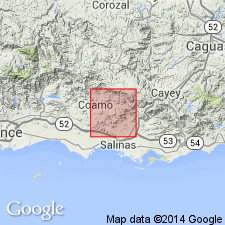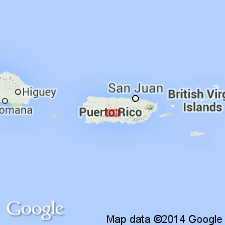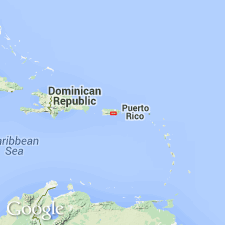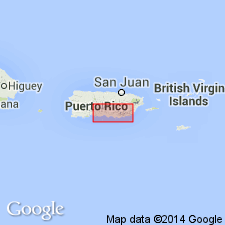
- Usage in publication:
-
- Coamo Formation*
- Modifications:
-
- Named
- Dominant lithology:
-
- Tuff
- Breccia
- Conglomerate
- AAPG geologic province:
-
- Caribbean region
Summary:
The Coamo Formation, here named, consists of massive volcanic rocks including tuff breccia, lapilli tuff, and tuffaceous conglomerate overlying several bedded units. The San Diego Lapilli Tuff Member, the Santa Ana Limestone Member, and a tuff breccia unit are named in the lower part. Conformably overlies the Cariblanco Formation; underlies the Cuevas Limestone with erosional unconformity. Maximum thickness is 1,599 m. Age is Late Cretaceous.
Source: GNU records (USGS DDS-6; Reston GNULEX).

- Usage in publication:
-
- Coamo Formation*
- Modifications:
-
- Revised
- AAPG geologic province:
-
- Caribbean region
Summary:
In west-central PR the Coamo Formation is restricted to the massive volcanic rocks, excluding the bedded units (San Diego Lapilli Tuff Member, Santa Ana Limestone Member, and unnamed conglomerate and sandstone and siltstone units) below the massive volcanic units. The conformably underlying Maravillas Formation has been defined to include the sequence below the restricted Coamo and limestone blocks and lenses in the Maravillas may be correlative with the Santa Ana Member and lapilli tuff and tuff lenses in the Jayuya quadrangle may be correlative with the San Diego Member. In the Jayuya quadrangle, the Coamo consists of coarse-grained tuff, lapilli tuff, and fine-grained volcanic breccia. Upper contact of the Coamo is removed by erosion. Thickness is 300 m. Age is Campanian to Maastrichtian based on fossils.
Source: GNU records (USGS DDS-6; Reston GNULEX).

- Usage in publication:
-
- Coamo Formation*
- Modifications:
-
- Revised
- AAPG geologic province:
-
- Caribbean region
Summary:
Mapping in the Orocovis quadrangle has shown that the Pozas Formation of the Ciales quadrangle is continuous with the so-called Coamo Formation of the Barranquitas quadrangle; therefore those rocks in the northwest Barranquitas are reassigned to the Pozas. The Rio Bauta Member is named at the base of Pozas in the Orocovis quadrangle. The Botijas Limestone and Reves Members are reassigned from the Coamo to the Pozas. Age is late Campanian to early Maastrichtian.
Source: GNU records (USGS DDS-6; Reston GNULEX).

- Usage in publication:
-
- Coamo Formation*
- Modifications:
-
- Revised
- AAPG geologic province:
-
- Caribbean region
Summary:
The heterogeneous lower part of the Coamo Formation is here included in the underlying Maravillas Formation and the massive upper 70% of the sequence is restricted to the Coamo. The part assigned to the Maravillas includes the San Diego and Santa Ana Members, leaving no members in the Coamo.
Source: GNU records (USGS DDS-6; Reston GNULEX).

- Usage in publication:
-
- Coamo Formation*
- Modifications:
-
- Overview
- AAPG geologic province:
-
- Caribbean region
Summary:
The Coamo Formation occurs in central Puerto Rico and consists of tuff and volcanic breccia with locally occurring andesitic lava flows and lenses of calcarenite. Maximum estimated thickness is 300 meters. The Coamo is of Late Cretaceous age.
Source: GNU records (USGS DDS-6; Reston GNULEX).
For more information, please contact Nancy Stamm, Geologic Names Committee Secretary.
Asterisk (*) indicates published by U.S. Geological Survey authors.
"No current usage" (†) implies that a name has been abandoned or has fallen into disuse. Former usage and, if known, replacement name given in parentheses ( ).
Slash (/) indicates name conflicts with nomenclatural guidelines (CSN, 1933; ACSN, 1961, 1970; NACSN, 1983, 2005, 2021). May be explained within brackets ([ ]).

